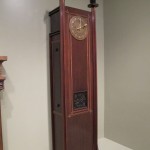We may receive a commission when you use our affiliate links. However, this does not impact our recommendations.
It’s difficult to have a serious conversation about the American Arts & Crafts movement without using the “S” word – Stickley, of course.
The iconic, rectilinear and medieval forms of Gustav(e) Stickley, his brothers and the other designers he employed are the nouns and verbs of the Arts & Crafts language – oak, leather, quartersawn, mortise-and-tenon.
But the early 20th-century design movement was so eclectic that I think sometimes we forget about the influence of the Europeans on pieces from Limbert and Shop of the Crafters. The mahogany and stringing of George Grant Elmslie. The traditional – almost classical – work of George Washington Maher.
When I first started collecting and building Arts & Crafts furniture in 1990, the Stickley stuff was out of the price range of a cub reporter making $300 a week. So I became a huge fan of Charles Limbert and his company in Grand Rapids, Mich.
Most early furniture collectors thought Limbert’s stuff was odd, a little Art Deco or Art Nouveau (both completely misguided assessments). I liked it, and it was dirt cheap. I bought the Limbert desk that I work on every day for less than $400 in 1992. It is as well-built as any piece of Gustav Stickley furniture and has a couple well-placed curves that make it less ponderous.
So I was delighted to find that the Art Institute of Chicago is showing some pieces of lesser-known makers from its permanent collection in the museum’s wing of 20th-century American Decorative Arts.
I even saw some pieces that were entirely new to me – a delightful surprise after 20 years of collecting. And so I wanted to share a few of them in the gallery below to help broaden what woodworkers think of when they hear the words “Arts & Crafts.”
Don’t get me wrong – I really like the work of the Stickleys and Charles and Henry Green. But between these two ends of the Arts & Crafts spectrum, there are a lot of designers that are worth exploring, including Zulma Steele, one of the most under-appreciated designers of the period. I’ve been reading a lot about Zulma lately and I hope to share some more of that information in 2013.
— Christopher Schwarz
P.S. One of the most under-appreciated books in the ShopWoodworking store is “Grove Park Inn Arts & Crafts” by Bruce Johnson. It’s a beautiful book and introduces you to a wide range of makers and sub-styles of the Arts & Crafts movement.
Shown in the gallery:
J.S. Ford, Johnson and Co. (1904 or 1905). Armchair made from oak, clearly screwed together.
David Wolcott Kendall’s “McKinley Chair” designed for the Phoenix Furniture Co. of Grand Rapids, Mich. The chair was designed for President William McKinley’s White House.
A George Grant Elmslie (1871-1952) armchair that has more Prairie influences than straight Arts & Crafts.
A George Grant Elmslie and William Gray Purcell (1880-1965) clock in mahogany. Made by the Niedecken-Walbridge Co.
Here are some supplies and tools we find essential in our everyday work around the shop. We may receive a commission from sales referred by our links; however, we have carefully selected these products for their usefulness and quality.




















Hmm… maybe it’s just me but the book (Grove Park Inn Arts & Crafts) doesn’t take me to where I can buy the book…
I totally want to build that last chair though, or maybe enough to seat my family at the dinner table! She-sah very nice! ;o)
Great stuff, Chris! Love it when the Jimmy Olsen in you shines through.
Chris,
Referring to some of Limbert’s furniture as Art Nouveau would not be misguided. The Ford chair closely resembles the work of Henry Van de Velde, who is a Belgian Art Nouveau designer. Charles Limbert employed a number of Austrian Designers, William Gholke and Paul Horti who were of the Viennese Secessionist school of design. This is a Germanic version of Art Nouveau and contemporaneous to French Art Nouveau.
Thanks for showing your readers that the Arts and Crafts style doesn’t end with Gus Stickley and Charles Green.
Now that is some seriously cool furniture.
The clock looks to have been possibly an influence on Wendell Castle, especially the form of his series of clocks most famously including the Ghost Clock. The rounded chair – very much like the look of pieces by Wharton Esherick.
Thanks for sharing these pieces.